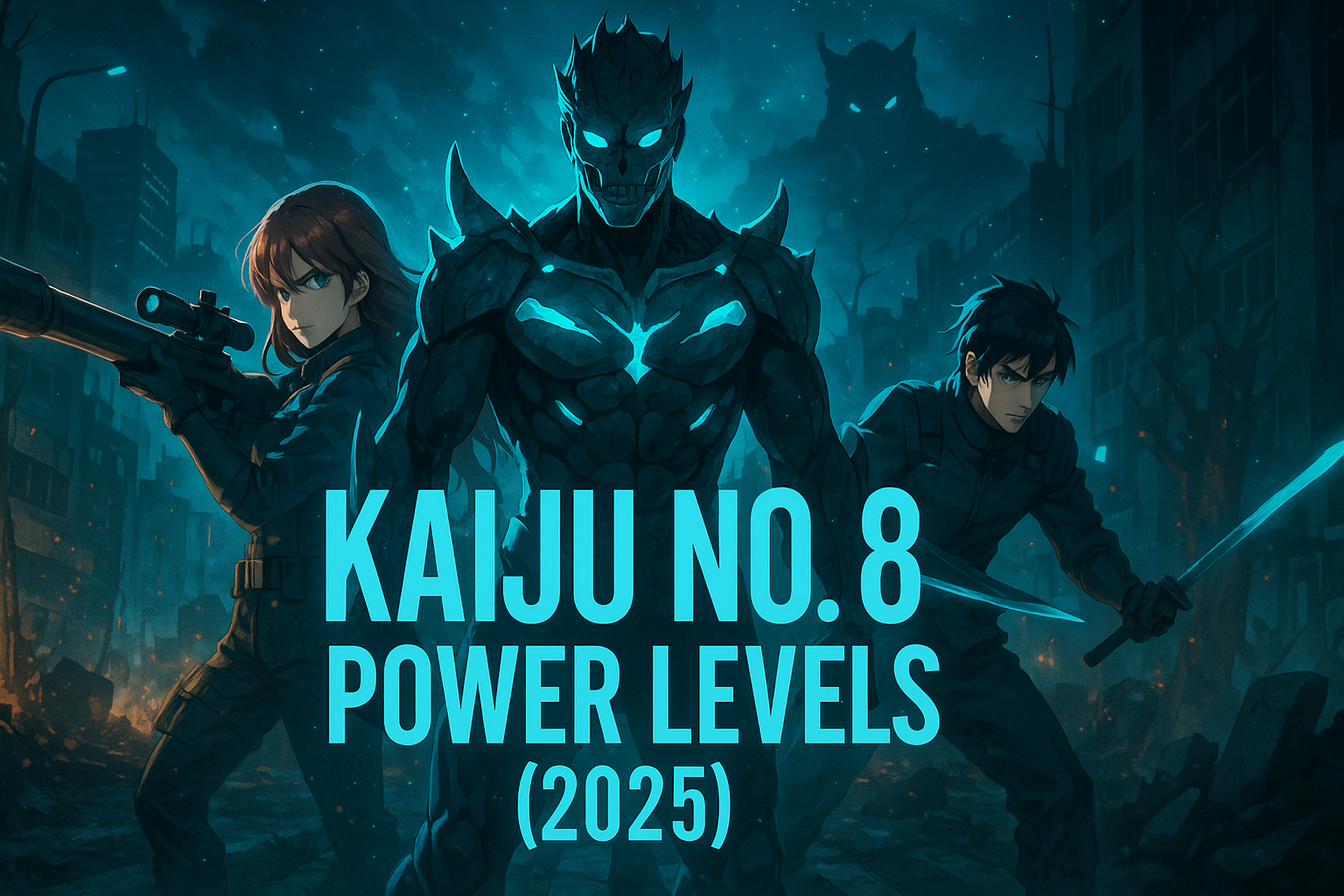Kaiju No. 8 Power Levels (2025) — Anime-First Tier List

Kaiju No. 8 Power Levels (2025) — Anime-First Tier List
Who actually tops the battlefield in Kaiju No. 8? This long-form tier list ranks Defense Force elites, Kafka’s No. 8 form, and adaptive kaiju using an anime-first lens. Manga-only and late-arc details are tucked into spoiler toggles so new viewers can read safely.
Method at a glance: We place characters by repeatable on-screen results against named threats, then adjust for kit depth (mobility, control, execution reliability), team value, and consistency. Kaiju “Fortitude” numbers are useful context but not destiny; we care about what a fighter can force on the map.
Power System 101 (Why Fortitude isn’t everything)
Kaiju No. 8 advertises power in quick numerals—Fortitude readings, Release Force %, weapon output—but fights hinge on positioning, kit matchup, and composure. To keep tiers honest, we weight:
Characters who display reliable win-conditions—pinning, dismembering, or deleting a threat class—move higher than peers with similar raw readings who can’t translate stats into victories.
Ground Rules
- Anime first. If the anime hasn’t depicted it clearly, it won’t set the main tier. We’ll reference it in spoiler toggles only.
- Numbers gears count when they are part of a character’s stable kit in the anime cut, not a single exhibition.
- Kaiju intelligence matters. Adaptive foes that learn, split, or parasitize get bumped for reliability in chaos.
- We update after major arcs or official clarifications on Fortitude readings and equipment.
Pieces that can flip a nation’s readiness by themselves. They force entire operations to reorganize around them.
Kafka Hibino — Kaiju No. 8 (controlled)
When Kafka stabilizes No. 8’s output and keeps his head, he is a walking countermeasure to classes of threats. It’s not just damage—he closes distance, shrugs off punishment, and ends fights cleanly.
Spoilers (equipment & late-arc scaling)
Later depictions underline that No. 8 can operate as both assassin and breaker. The path to “national protector” is paved by composure, not just numbers.
Kaiju No. 9 — Adaptive Humanoid
No. 9 doesn’t win by bigger blasts; it wins by changing the rules—body theft, data harvesting, and battlefield manipulation. Every encounter becomes worse if it walks away.
Spoilers (forms & possession)
Deeper arcs show a portfolio of tricks that make No. 9 the most dangerous long-term piece on the board: it scales while you plan.
Operators whose mere presence lets a division engage Daikaiju with confidence.
Mina Ashiro — 3rd Division Captain
Mina’s kit isn’t splashy—it’s precise. She takes pieces off the map at ranges where most kaiju still posture. Her calm comms keep the team’s risk low while pressure stays high.
Scaling notes
Her effectiveness rises with recon and setup. Give Mina time to range the target and the fight becomes math.
Soshiro Hoshina — Vice-Captain
Hoshina dismantles threats up close with impeccable blade discipline and tempo shifts. When the operation needs a finisher inside the danger zone, he signs the form.
Spoilers (gear trajectory)
Later equipment choices magnify his strengths rather than cover weaknesses, turning “dangerous” into “unfair” in tight spaces.
Isao Shinomiya — Director General
On the rare occasions he enters the line of fire, the mission parameters change. Power plus experience equals ruthless risk control.
Spoilers (relic gear)
Numbers-class integration puts him in the conversation with national-level pieces. The price is strain—he pays it without blinking.
Fighters who can headline most operations, and kaiju that demand captain-level answers.
Kikoru Shinomiya — Prodigy
Kikoru’s ceiling is the story. She pairs raw readings with a rare ability to reset mentally mid-engagement—exactly what you want against adapting foes.
Scaling notes
As her fundamentals catch up to her numbers, she transitions from “promising” to “problem” for Daikaiju.
Intelligent Humanoid Kaiju (late-season)
Not every humanoid is a No. 9, but the combination of coordination and tool use pushes them above raw Fortitude peers.
Heavy-type Daikaiju
These are the monsters that chew up squads. Without proper angles (Mina) or surgical entries (Hoshina), trading is a losing game.
They don’t warp the map like SS, but they make raids winnable, period.
Division Captains (other)
Whether long-range, artillery, or brawler archetypes, these leaders translate intel into safe progress. Their teams make fewer mistakes.
Specialist Operators (artillery / support)
They control space, feed data, and keep the frontline alive. Not flashy; absolutely necessary.
Agile Mid-Kaiju
These are the tests trainees fail—fast, tricky, and lethal if you blink.
Reliable building blocks. They win with numbers, planning, and support rather than solo heroics.
Trainees (Kafka pre-transformation cohort)
They pass or fail on fundamentals—angles, callouts, and trust. The show cares about those habits because that’s how you survive to become a captain.
Swarm & Fodder Kaiju
Not dangerous individually; catastrophic when you get cute. They exist to punish lapses.
No. 8 vs. the Defense Force: How the Scale Tips
Kafka’s secret creates a weird axis for the story. On paper, the Defense Force is designed to contain entities like No. 8; in practice, Kafka’s control and empathy make him the ideal countermeasure. Mina’s methodical range keeps civilians safe while Kafka solves the unsolvable problems up close. Hoshina bridges the gap—his reads and footwork buy time when No. 8 can’t appear or when the enemy adapts faster than expected.
Frequently Asked Questions
“Does Fortitude automatically decide tiers?”
No. It’s a great shorthand, but battlefield intelligence, kit synergy, and execution under pressure swing fights more often than +0.3 on a scanner.
“Why isn’t every Numbers user SS?”
Numbers gear is a multiplier, not a personality transplant. If the operator can’t place shots, manage strain, or keep comms clean, the risk outweighs the reward.
“Where will Kikoru land by the end of the anime?”
Trajectory says S or SS depending on how quickly fundamentals catch up to her raw output. The anime emphasizes her growth curve—expect jumps after each hard lesson.
Your turn: Who’s the most underrated operator—Hoshina, Kikoru, or a captain we barely know yet? Drop episode+timestamp receipts in the comments. We’ll feature the best analyses in the next update.